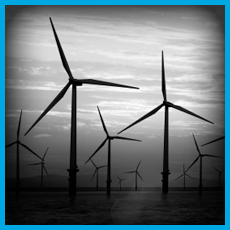OVERVIEW
Like rivers that flow through dams, the kinetic energy in wind can be captured and turned into power. Currently, there are 46 gigawatts of wind capacity installed in the U.S.1 Still, much room for growth remains. According to a recent report by the Department of Energy, the potential of wind is equivalent to ten times the current total electricity capacity of the U.S. today.2 Unlike fossil fuels or nuclear, once built, wind power requires no additional fuel costs,3 providing a hedge against volatile coal and natural gas prices in this age of market instability and global trade. Furthermore, wind generation produces no greenhouse gasses or harmful pollutants. Yet, despite these benefits, more can be done to encourage wind development.
ANALYSIS
The wind industry has been growing quickly. In 2010, 5,000 new megawatts of wind were installed4 and 75,000 Americans worked in the U.S. industry.5 Wind turbines have an increasing amount of American content as the American supply chain develops, with as much as 67% made in the United States.6 But the industry still faces problems of cost, siting, and grid access that adversely impact the future of wind. Today the “levelized cost”7 of energy for wind is nearly 150% that of natural gas.8 Furthermore, new projects on federal land face regulatory burdens that impede progress.
Government incentives remain critical in the short-term for the widespread deployment of wind. Whether it is an extension of the Production Tax Credit (PTC), the Investment Tax Credit (ITC), or new, stepped-down policies, the federal government should continue to support the wind industry until it scales to a competitive level. If these policies are adopted, they could add roughly 2 additional GW of wind every year through 2025, enough new electricity each year to power at least 1.5 million homes.9 That is about the same amount of power that is needed by all residents in West Virginia and Iowa combined.10 Assuming the new turbines replaced coal, the 26 GW of wind that could be added by 2025 would eliminate as much as 75 megatons of greenhouse gas emissions.11 And wind produces no conventional pollutants (like nitrogen and sulfur oxides, mercury, and particulate matter), so increasing wind by this amount could remove as much conventional air pollutants every year as produced by about 19 average-size coal plants.12
IMPLEMENTATION
To ensure wind energy continues to grow across the nation and especially in the Midwest, the federal government should adopt policies that channel funding to wind asset development and streamline the process of approving licenses for transmission and generation projects.






